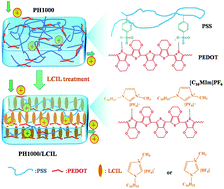Liquid-crystalline ionic liquids modified conductive polymers as a transparent electrode for indium-free polymer solar cells†
Abstract
Ordered microstructure and high conductivity of poly(3,4-ethylenedioxythiophene):poly-(styrene sulfonate) (PEDOT:PSS, commercial product PH1000) films for a transparent anode were obtained by liquid-crystalline ionic liquids modification. By spin-coating 1-hexadecyl-3-methylimidazolium hexafluorophosphate ([C16MIm]PF6) or 1-hexadecyl-3-methylimidazolium tetrafluoroborate ([C16MIm]BF4) on the PH1000 film, half of the insulating PSS on the top surface of PH1000 could be successfully removed and the PEDOT formed an ordered and continuous molecular packing. The conductivity of PH1000 dramatically increased from 0.4 S cm−1 to 1457.7 S cm−1 for PH1000/[C16MIm]PF6 and 1243.8 S cm−1 for PH1000/[C16MIm]BF4. At the same time, spontaneous orientation of the liquid-crystalline ionic liquids with liquid-crystallinity further promoted the ordered packing arrangement of both PH1000 and the active layer. The power conversion efficiency based on PH1000/[C16MIm]PF6 and PH1000/[C16MIm]BF4 as the anode is comparable to that obtained from the device with indium tin oxide (ITO) as the anode. In addition, liquid-crystalline ionic liquids modification is also good for the energy alignment, facilitating charge injection and transport, without any extra hole transport layer. Furthermore, these novel liquid-crystalline ionic liquids modification PH1000 anodes have potential applications in the fabrication of ITO-free large-area flexible printed polymer solar cells.


 Please wait while we load your content...
Please wait while we load your content...